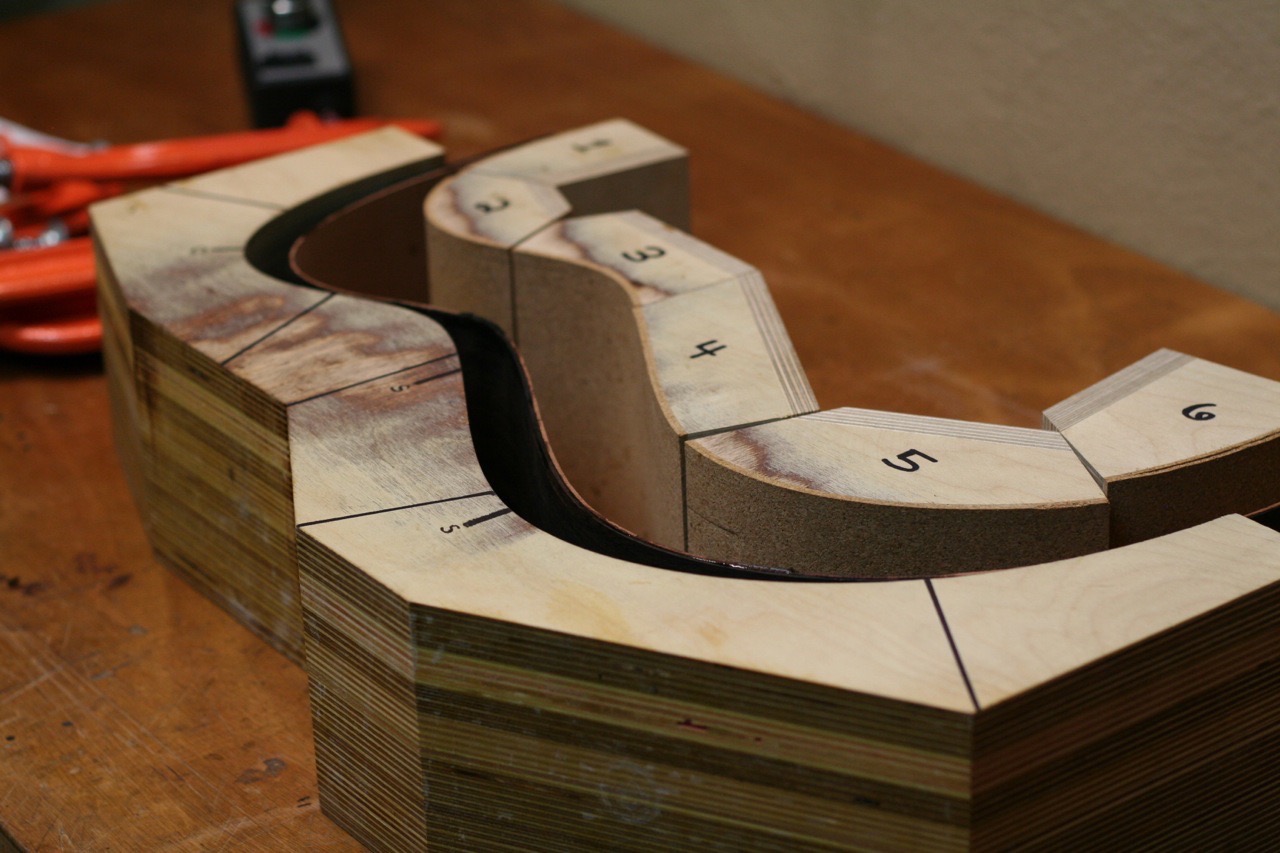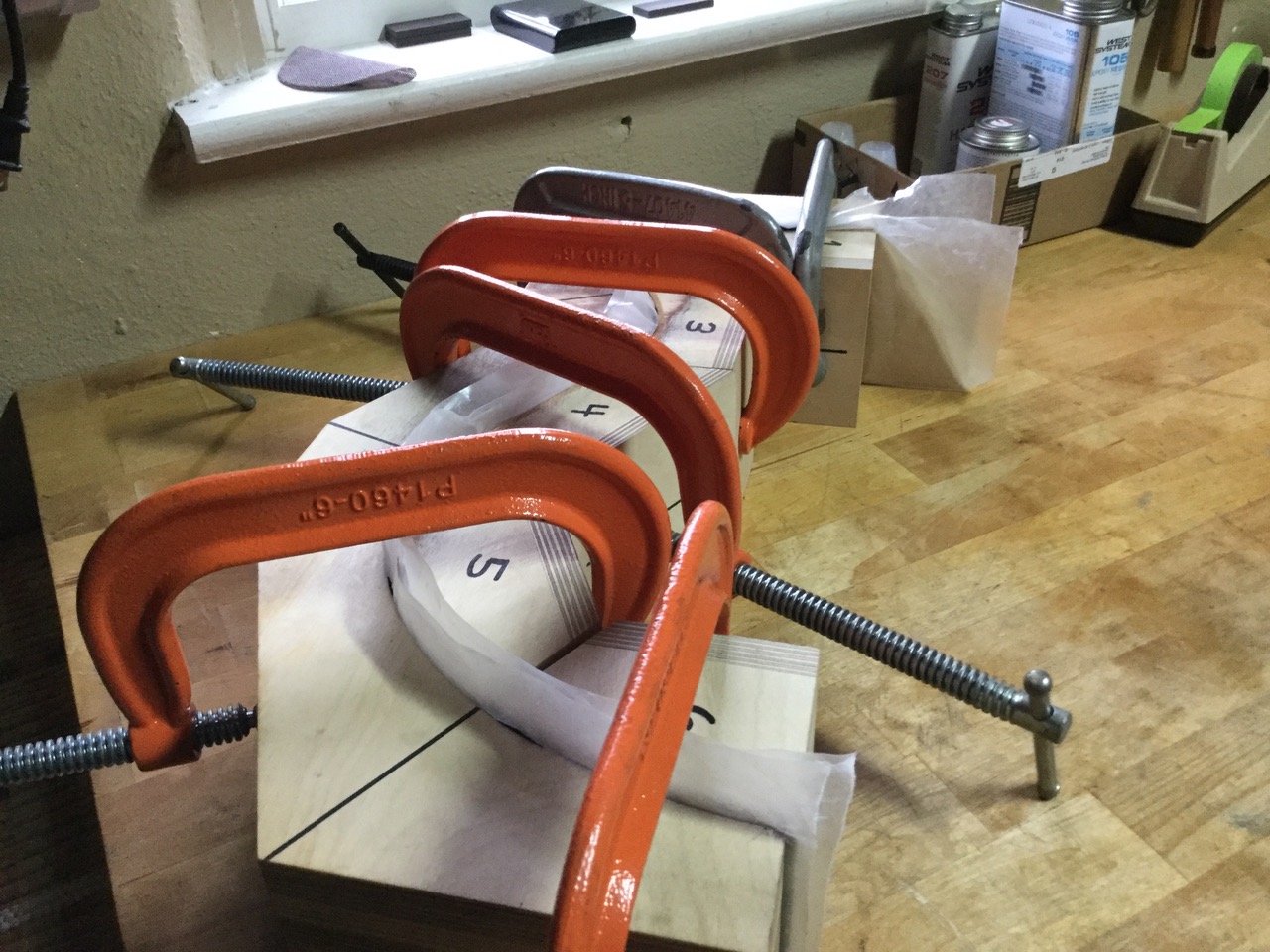
 |
|
#1
|
|||
|
|||
|
I have been designing a guitar shape, and finally have it in vector format. I want to begin making molds for it, but I have a question about the molds for side-bending machines.
When you bend sides, most often you have spring steel, a heat blanket, aluminum foil (around the wood), the wood itself, then another sheet of spring steel. Depending on the thickness of the spring steel, if the wood is about .080 inches thick, your sides will be bent to a width about 0.12-0.16 inches thicker than the width of the guitar you're trying to build. So if you're shooting for a width of 16" to the lower bout, if your side-bending molds are exactly the width of your design, the wood will end up bent for a design up to 1/4 wider than what you were aiming for. I'm wondering how most people account for this. Every piece of wood is different, and I guess I'm not sure how precise you need to be. Has anyone built these molds before, and come up with a solution for this problem? An additional question: I also hope to make doubled (laminate) sides for my guitars. Would you bend both pieces at the same time (so that one is bent to fit inside the other), or would you bend them separately? And if they are bent together, are there any issues with heat transferring through both pieces, and if the woods are different, are there other issues with staining, etc.? Thank you for your help. - Colby |
|
#2
|
|||
|
|||
|
Colby,
Yes - bend both pieces at the same time. Typical thickness for laminate sides range from about 0.050" to 0.090". Bending thinner pieces is much easier and one of the benefits of using laminate sides and so I would advise you to aim for around maybe 0.060" for the laminates. You can always change it as you continue building more guitars. As regards the bending forms, you don't need to be that accurate. I will generally touch everything up on a bending pipe before I laminate. Some sides will come out of the bender perfect but most need a little bit of additional work on the bending pipe. For this reason, it helps to create more extreme curves for your bending mold. In other words, slightly exaggerating the upper and lower bout curves can help eliminate any spring back. For the laminating mold, you do want to be accurate. You simply need to account for the thickness of your laminate construction if you use a laminating jig that has an "interior/inside" form. I don't do that tho' -- my laminating mold exactly replicates the body shape and I recommend doing it the way I do. Also, use epoxy for laminating as other glues introduce moisture. Here's a photo:  
|
|
#3
|
||||
|
||||
|
FYI: I use the same bending form in my Fox-style bender for 0, 00, and 000 size guitars. I also use another single form for OM, my slightly different OM equivalent, and my asymmetrical guitars in the same size range, as well as 16 wide asymmetrical guitars. With minor hot pipe touch up I can use those forms for many other sizes and shapes. My only additional forms are for classical, dreadnought, and surprisingly, the L00, which is just far enough from an OM to rationalize its own form.
I use Stainless steel rather than spring steel, and I do not wrap my sides in anything. My forms have in common that they overbend the sides (one at a time in my case) at every curve by about 10% to compensate for spring back. Last edited by Bruce Sexauer; 09-05-2022 at 03:19 PM. |
|
#4
|
|||
|
|||
|
Quote:
When you mention the "laminating mold", do you have a specific interior or exterior mold that you use only for laminating the sides? It seems to me an interior mold would work better because if the sides end up thicker because of the additional laminate, it wouldn't add to the overall width of the guitar (because the extra thickness would extend inside, not outside - if that makes sense). If the laminate wood is different from the back/side wood, have you ever experienced oils from the laminate piece staining the side piece when bending them together? Oh, and your images aren't showing up for some reason. |
|
#5
|
|||
|
|||
|
Hi Colby,
I might be misunderstanding you ... but I see the exact other way around actually. Basically, my laminating jig is exactly the same as my body mold (for gluing the headblock/tailblock and when attaching the top and back plates). Obviously, it is just half of the body mold and I have an additional mold for my Florentine cutaway. If you do an outside mold, you make the jig represent the body shape exactly. With an interior mold, you have to adjust the shape in order to account for the laminate thickness. Honestly, we are splitting hairs here tho' -- you don't have to be that exact. If you keep building, you're going to make so many changes to your process over time anyway. if you still can't see pictures, then visit this link and look for the laminating jig. If you have any lutherie questions, you are welcome to call me. Leave a message as I don't answer unknown numbers and I'll call you back. http://www.fayguitars.com/Guitars/Gallery/workshop.html Last edited by Simon Fay; 09-06-2022 at 08:24 PM. |
|
#6
|
|||
|
|||
|
Quote:
|
 |
|
| Tags |
| bending problems, jigs, laminate back and sides, side bending |
|
|